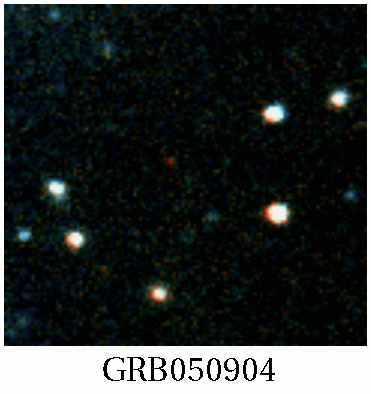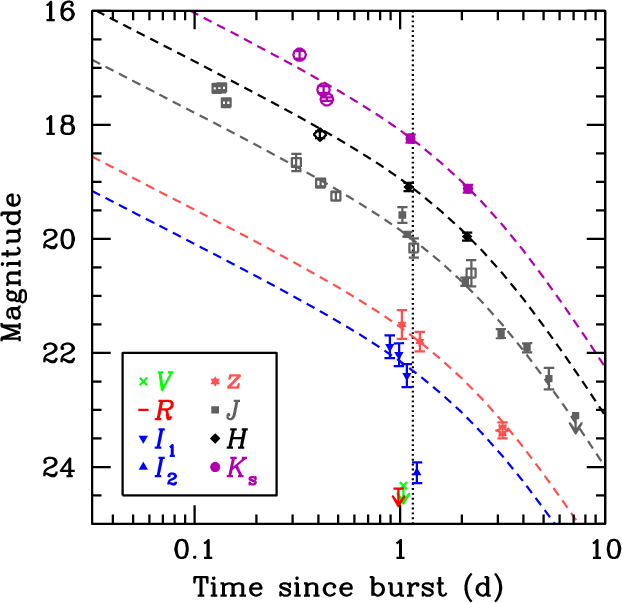
A. J. Castro-Tirado1 , J. Gorosabel1, A. de Ugarte Postigo1, M. Jelínek1, S. Guziy1,2, S. B. Pandey1,3, J. M. Castro Cerón4 and M. D. Pérez-Ramírez5
(1)
Instituto de Astrofísica de Andalucía, CSIC,
Apt 3004, E-18080 Granada, Spain
(2)
Nikolaev State University,
Nikolskaya 24, 54030 Nikolaev, Ukraine
(3)
ARIES Observatory ,
Manora Peak, Nainital, 263129 India
(4)
Niels Bohr Institute, Copenhagen University,
Juliane Maries Vej 33, 2100 Copenhagen, Denmark
(5) Universidad
de Jaén ,
Virgen de la Cabeza s/n, Jaén, Spain
Introduction
Since their discovery nearly 40 years ago, gamma-ray bursts (GRBs)
are still among the greatest puzzles of modern astrophysics.
Important advances have been obtained over the past ~ 10 years
thanks to the detection of X-ray, optical, millimetre and
centimetre radio afterglows, and with the identification of
several dozens of host galaxies and about 40 redshift determinations,
placing them (at least those lasting longer than 2 s) in the
redshift range 0.168-4.50, with the later being the record for more
than 5 yr (Andersen et al. 2001).
The nature of the progenitors for this subclass of long-duration GRB
is now accepted to be the so-called "collapsars": massive stars ending
their lives with the formation of a black hole as a result of core
collapse (MacFadyen and Woosley 1999).
These very energetic supernovae (or "hypernovae") display
a highly collimated emission in a form of a powerful jet. A series of
internal shocks produce the observed gamma-ray emission and the
resulting relativistic blastwave interacts with the interstellar medium,
causing the afterglow phase of GRBs, continuously energizing the
swept-up particles and thereby slowing down its own
bulk velocity. The afterglow properties are only weakly dependent on
the details of the event that produced the blast wave.
In this scenario, it is believed that GRBs can help determining the
unobscured star-formation rate in the early universe and in fact,
be detected up to very high redshifts ( z = 10-20) and be the
signature
of the first stellar black holes formed in the Universe following the
dearth of Pop III stars
(Meszaros and Rees 2003).
With the launch of the SWIFT GRB
mission in Nov 2004 (2.5 times more sensitive that its predecessor, the
BATSE instrument aboard the CGRO ), it was clear that
more distant events were going to be detected (Gorosabel et al. 2004).
Observations
On 4 Sep last year, SWIFT detected an unusually long (225 s)
GRB
starting at 01:51:44 UT. The slowly rising source was detected thanks
to the very sensitive imaging triggering software developed at LANL,
so a preliminary position could be determined onboard. This prompted
inmediate follow-up observations at robotic observatories like
BOOTES-1 in South Spain (Castro-Tirado et al. 2005)
and TAROT in France (Boer et al. 2006). The initial results
were discouraging, as no optical counterpart was detected by the
robotic telescopes of BOOTES in south Spain (with
R-band images starting 124 s after the onset of the event).
However, about 3 hr after the event, near-IR imaging at the 4.1m SOAR
telescope in Cerro Tololo (Chile) revealed a bright near-IR counterpart
and it was suggested that GRB 050904 could be at high redshift.
Indeed, a set of optical and near-IR images were to confirm this
early time suspicions.
First, we triggered our target-of-opportunity programme at the
2.2m CAHA and got
a sequence of alternating images in two filters (I-R-I-R-I).
The initial anaylisis already showed that a faint object was
detected with I = 21.9 +/- 0.2 at the position of the reported
nIR afterglow (Fig. 1) and that faded by 0.5 mag in the 7 hr time
interval
during which our images were taken (Fig. 1). At the same time, only un
upper limit was obtained in the R-band (> 24.1). Therefore,
an indication of R - I > 2.5 already pointed out to the likely
existence of the Ly-alpha break sitting on this wavelength range.
Near-IR Observations at ESO's Paranal and La Silla Observatory were
also triggered by the MISTICI Collaboration simultaneously to our
Calar Alto optical observations. Therefore we decided to join efforts
and get the complete SED from the optical to the Ks near-IR band.

Results
Haislip et al. first reported the discovery of the afterglow of GRB 050904,
together with the early-time BOOTES observations and the identification of
GRB 050904 as the first very high redshift GRB (Haislip et al. 2006).
From the optical and near-infrared observations of the afterglow
of the gamma-ray burst GRB 050904 (including the CAHA data), a
photometric redshift z = 6.3 +/- 0.1 (Fig. 2), was
estimated from the presence of the Lyman break falling between the I and J
filters. This is by far the most distant GRB known to date. Its
isotropic-equivalent energy is 3.4x1053 erg in the rest-frame
110-1100 keV
energy band. Despite the high redshift, both the prompt and the afterglow
emission are not peculiar with respect to other GRBs. A break in the
J-band light curve was observed at tb = 2.6 +/- 1.0 d
(observer frame). See Fig. 3.
If we assume this is the jet break, a beaming-corrected energy Egamma =
(4-12)x1051 erg is derived.
This detection is consistent with the expected
number of GRBs at z > 6 and shows that GRBs are a powerful tool to study the
star formation history up to very high redshift (Tagliaferri et al. 2005).


Conclusions
In 2000, Lamb and Reichart predicted that gamma-ray bursts (GRBs)
and their afterglows occur in sufficient numbers and at sufficient
brightnesses at very high redshifts (z > 5) to eventually replace
quasars
as the preferred probe of element formation and reionization in the early
universe and to be used to characterize the star-formation history of the
early universe, perhaps back to when the first stars formed
(Lamb and Reichart 2000).
GRB 050904 has been identified as the first very high redshift GRB.
These high redshift events will likely drive a new era of study of the
early universe, using GRBs as probes.
Andersen, M. et al. 2000, VLT identification of the optical afterglow of the gamma-ray burst GRB 000131, A&A 364, L54
We expect that Calar Alto will
continue as one of the reference astronomical observatories world-wide
for the study of the most distant events in the Universe. Prior to the
Swift launch in Nov 2004, a significant fraction of events
were discovered (and studied) at Calar Alto. But the success rate is not
so high after that time, due to the severe limitation on the number of
triggers/semester in spite of Swift detecting about 50 GRBs/year
now. In order for Calar Alto to continue at the leading edge,
we need to significantly increase the number of allotted
triggers/semester of 3 to about 10, as is the case at other larger
facilities (TNG, WHT, Gemini, VLT) in this Swift Golden Age.
References
Boer, M. et al. 2006, ApJ, in press (astro-ph/0510381)
Castro-Tirado, A. J. et al. 2005, Simultaneous and optical follow-up GRB observations by BOOTES, Il Nuovo Cimento 2005, vol. 28, 715
Gorosabel, J. et al. 2004, The potential of INTEGRAL for the detection of high redshift GRBs, A&A 427, 87
Haislip, J. et al. 2006, Discovery and identification of the very high redshift afterglow of GRB 050904, Nature, in press (astro-ph/0509660)
Kawai, N. et al. 2006, Afterglow spectrum of a gamma-ray burst with the highest known redshift z=6.295, Nature, in press (astro-ph/0512052)
Lamb, D. Q. and Reichart, D. E. 2000, Gamma-Ray Bursts as a Probe of the Very High Redshift Universe, ApJ 536, 1
MacFadyen, I. and Woosley, S. E. 1999, Collapsars: Gamma-Ray Bursts and Explosions in "Failed Supernovae", ApJ 524, 262
Meszaros, P. and Rees, M. 2003, Gamma-Ray Bursts as X-Ray Depth Gauges of the Universe, ApJ 591, L91
Tagliaferri, G. et al. 2005, GRB 050904 at redshift 6.3: observations of the oldest cosmic explosion after the Big Bang, A&A 443, L1
Totani, T. et al. 2006, Implications for the Cosmic Reionization from
the Optical Afterglow Spectrum of the Gamma-Ray Burst 050904 at z = 6.3, ApJ, in
press (astro-ph/0512154)
Zou Y.-C. et al. 2006, Is GRB 050904 a super-long burst?, ApJ, in press (astro-ph/0511205)